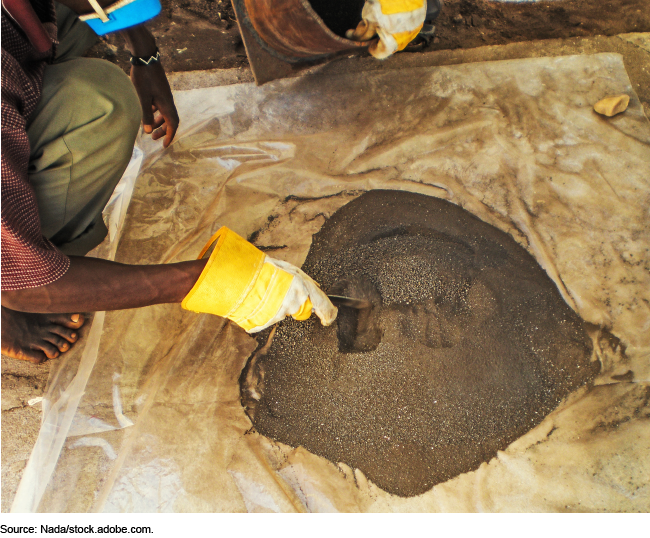Conflict Minerals: 2022 Company Reports on Mineral Sources Were Similar to Those Filed in Prior Years
Fast Facts
Armed groups in the Democratic Republic of the Congo and adjoining countries reportedly exploit the minerals tin, tungsten, tantalum, and gold to finance conflict in the region. The Securities and Exchange Commission requires companies to report on the origin of these "conflict minerals" used in their products.
We found that company inquiry results haven't changed much since 2015. In 2022:
51% of companies initially determined that their conflict minerals may have come from the DRC or adjoining countries
53% of companies that investigated further were unable to make a final determination on conflict mineral origins
Coltan ore, used to make tantalum, is mined in the Democratic Republic of the Congo

Highlights
What GAO Found
The U.S. Securities and Exchange Commission (SEC) disclosure rule on conflict minerals broadly requires that certain companies submit a filing that describes their efforts to conduct a reasonable country-of-origin inquiry for necessary conflict minerals used in their products. These minerals include tin, tungsten, tantalum, and gold. Depending on the determination reached through this inquiry, some companies must then conduct due diligence to further investigate whether these minerals came from covered countries, which include the Democratic Republic of the Congo (DRC) and adjoining countries.
Companies' reasonable country-of-origin inquiry determinations have not changed significantly since 2015, according to GAO's analysis. In 2022, an estimated 51 percent of companies made preliminary determinations about whether the conflict minerals in their products may have come from the DRC or other covered countries. Of those companies that went on to perform due diligence, an estimated 53 percent reported they could not determine whether the minerals used in their products originated in covered countries.
Source of Conflict Minerals in Products as Preliminarily Determined by Companies' Reasonable Country-of-Origin Inquiries, Reporting Years 2014–2022

Note: Estimates have a margin of error of no more than plus or minus 10 percentage points.
Many companies used standardized tools and programs, including supplier surveys, smelter and refiner audit programs, and traceability schemes, to attempt to determine the source of their minerals. However, some companies experienced challenges related to their due diligence efforts, according to GAO's analysis of filings and interviews with industry stakeholders. Such challenges included difficulties getting needed information because of lack of access to suppliers and complex supply chains. Industry stakeholders said that some companies are reporting supply chain information beyond that required by the SEC rule. Conversely, some industry stakeholders noted that other companies may be reporting incomplete information, or not filing at all, because of a perception that they are unlikely to face enforcement action by the SEC if they do not comply with the conflict minerals disclosure requirements.
Why GAO Did This Study
The United States, along with the international community, has sought to improve peace and security in the DRC for over 2 decades. However, according to the Department of State and the United Nations, conflict has persisted and contributed to severe human rights abuses and the displacement of people. Armed groups continue to profit from the mining and trade of conflict minerals, according to State.
Provisions in the 2010 Dodd-Frank Wall Street Reform and Consumer Protection Act required, among other things, the SEC to promulgate disclosure and reporting regulations regarding the use of conflict minerals from the DRC and adjoining countries. In 2012, the SEC adopted a conflict minerals disclosure rule requiring companies to file specialized disclosure reports beginning in 2014 and annually thereafter.
The act also includes a provision for GAO to assess, among other things, the SEC rule's effectiveness in promoting peace and security in the DRC and adjoining countries. This report examines how companies responded to the SEC conflict minerals disclosure rule when filing in 2022. GAO analyzed a generalizable sample of 100 SEC filings; reviewed SEC documents; and interviewed SEC officials and industry stakeholders, including representatives from filing companies, business organizations, and non-governmental organizations.
For more information, contact Kimberly M. Gianopoulos at (202) 512-8612 or gianopoulosk@gao.gov.
